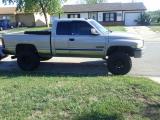- Replies 32
- Views 8.1k
- Created
- Last Reply
Top Posters In This Topic
-
 DieselD24 10 posts
DieselD24 10 posts -
 Heavyd1980 5 posts
Heavyd1980 5 posts -
 ISX 4 posts
ISX 4 posts -
 volkswagon 4 posts
volkswagon 4 posts


Upgrading your diesel.
In order to upgrade your diesel from stock, you should have a baseline of readings in order to know what has changed. Also, if you do multiple upgrades at one time and something goes wrong, you will not know which upgrade caused the problem or error code.
In order to know what is happening to the engine, you should have at the minimum compliment of aftermarket gauges. At the minimum for Dodges, you need a fuel pressure gauge, boost gauge, and EGT gauge. Those with automatic transmissions should also have a transmission temperature gauge. With these gauges and a stock engine you will proceed to gather information as to how well the engine is running. Starting with a baseline of readings, you will be able to determine what is happening to the engine and transmission as you add more upgrades.
The suggested order for upgrades should be as follows:
1. Gauges: http://forum.mopar1973man.com/threads/3114-Dodge-Gauges
2. Better intake, i.e. CAI, ram air, etc.
3. Bigger exhaust, 4” is for about 500 HP, 5” for 500+ HP and deeper sound
4. Transmission, i.e. better clutch for manuals or stronger bands, billet input shaft, torque converter, valve body, etc. for auto’s
5. Fuel system
6. Larger injectors
7. Fueling box or chip, timing
8. Larger turbo
By doing these upgrades in this suggested order, you will be able to know what is happening to your engine as they are being added.
With the addition of gauges, the next step is to get the air into and out of the engine, as diesels are large air pumps. The easier in, the easier out, the cooler the engine will run, i.e. lower EGT temps, and less of a chance of damaging the engine.
Most transmissions are sometimes just barely able to hold the stock power that is produced. When you start upgrading the engine, the transmission will start to suffer. So upgrading the transmission before it is destroyed/slipping is easier than buying a new or replacement.
When upgrading the fuel system, you can get a larger lift pump to supply more fuel to the injection pump. When doing this you should also upgrade the fuel delivery lines to a larger size. This is to allow or more fuel to be moved from the tank to the IP, and the excess fuel is returned to the tank along with cooling the injector pump.
The next upgrade should be injectors. Depending on your application is what type of injector that you will need. For Dodges with the VP-44 injection pump, the most common are RV275’s which give about 45 hp.
The fueling box/chip and timing promoter can be any number of manufacturers. Depending on your application, is what type of electronic device that you will want. With certain electronics, you can stack them with others. Therefore, whichever chip/programmer that you choose, be sure that you do your research.
Now, in considering a larger turbo, you need to think about the application. Also, think about twins, triples, or quads, these are also known as compound turbos. When going to a larger turbo, there comes into play the turbo lag. The spool up of the turbo may become a problem , as to making excess smoke when just applying light amounts of throttle. When using compound turbos, the smaller turbo fills in for the turbo lag of the larger one. Making the smoke problem easier to control.
More Information to be added.